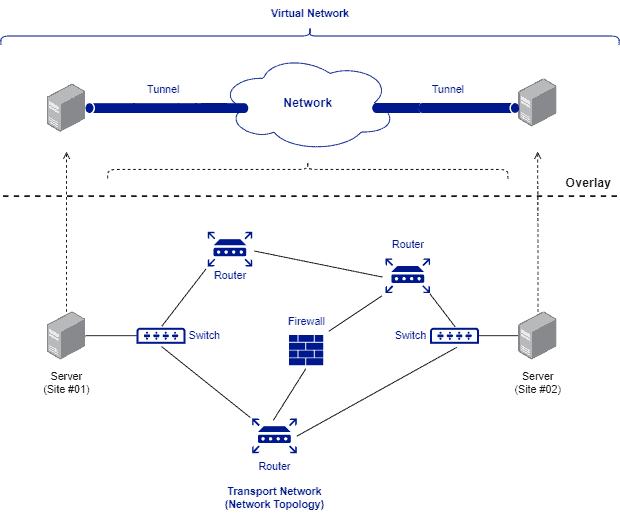1. 引言
在本篇文章中,我们将深入探讨 Underlay Network(底层网络) 与 Overlay Network(覆盖网络) 之间的区别。现代网络依赖于多种物理与逻辑资源协同工作,而这些资源通常被划分为 Underlay 和 Overlay 两部分。
为了全面理解这两者的差异、相似之处及其相互关系,我们将首先回顾现代网络的基本工作原理,然后分别介绍 Underlay 和 Overlay 的核心概念,并通过示例加深理解。最后,我们会通过一个系统性对比来总结它们的特点。
2. 现代网络是如何工作的
现代网络结构复杂,依赖大量物理与逻辑资源才能正常运行。在网络核心部分,我们通常会看到各种物理设备(如交换机、路由器等),它们负责网络流量的转发——这是网络最基础的功能:将数据从一个点传输到另一个点。
在这些物理设备之上运行着各种网络协议,其中大多数属于 OSI 模型的低层协议,主要包括:
- 数据链路层(Data Link Layer):如 PPP(点对点协议)、ARP(地址解析协议)
- 网络层(Network Layer):如 IPv4、IPv6、ICMP(控制报文协议)
- 传输层(Transport Layer):如 TCP(传输控制协议)、UDP(用户数据报协议)
在核心网络之上,还有各种服务器提供数据和服务。这些服务通常使用 OSI 模型的高层协议(会话层、表示层、应用层),例如 HTTP、FTP、SMTP 等。它们的主要任务不是传输数据,而是处理和解析数据。
3. Underlay Network(底层网络)
Underlay 网络指的是所有能够实现数据帧和包从一个点转发到另一个点的物理基础设施。简单来说,它是网络设备之间连接与通信的基础环境。
Underlay 网络包括以下关键元素:
✅ 交换机、路由器等网络设备
✅ 网络布线系统(如光纤、网线)
✅ 物理拓扑结构
从 OSI 模型来看,Underlay 网络主要涉及前三层:
- 物理层(Physical Layer)
- 数据链路层(Data Link Layer)
- 网络层(Network Layer)
有时,传输层(第四层)也与 Underlay 有关,但更多是作为 Underlay 与 Overlay 的过渡层。
下图展示了一个典型的 Underlay 网络拓扑结构:

踩坑提醒 ⚠️
Underlay 网络的一个主要挑战是灵活性与扩展性差。由于它依赖物理设备,网络拓扑的调整通常需要人工介入,例如重新布线或更换设备。
不过,随着 NFV(网络功能虚拟化) 和 SDN(软件定义网络) 技术的发展,Underlay 网络正逐步向软件化方向演进,从而提升其灵活性与可管理性。
Underlay 网络的核心协议主要包括以太网交换、路由协议(如 OSPF、BGP)等。
4. Overlay Network(覆盖网络)
Overlay 网络是在 Underlay 网络之上构建的虚拟网络,它通过软件方式实现流量传输,抽象了底层网络的转发细节。
可以将 Overlay 网络理解为一种虚拟网络的实现方式。它利用 Underlay 提供的物理资源,构建出多个逻辑上独立的网络,无需改动 Underlay 结构。
Overlay 网络的主要作用包括:
✅ 在不同物理网络之间建立虚拟连接
✅ 实现多租户隔离
✅ 构建跨地域的虚拟网络环境
下图展示了在一个 Underlay 网络基础上构建的多个 Overlay 网络:

常见 Overlay 协议
Overlay 网络依赖一些封装协议来实现数据传输,常见的包括:
| 协议 | 描述 |
|---|---|
| VXLAN | 通过 UDP 封装实现跨三层网络的二层连接 |
| GRE | 点对点隧道协议,用于在公网中建立虚拟连接 |
| IPSec | 提供加密与认证功能,保障 Overlay 通信安全 |
优点与挑战
✅ 优点:灵活、易于扩展、支持虚拟化
❌ 缺点:需要额外的封装与加密过程,可能导致性能开销,如延迟增加、吞吐量下降
5. 系统性对比总结
为了帮助你更清晰地理解 Underlay 与 Overlay 的区别,下面是一个对比表格:
| 特性 | Underlay Network | Overlay Network |
|---|---|---|
| 协议 | 以太网、IP、路由协议等 | VXLAN、GRE、IPSec 等 |
| 扩展性 | 扩展困难,灵活性差 | 扩展容易,灵活性高 |
| 控制方式 | 硬件控制为主 | 软件控制为主 |
| 封装方式 | 标准的二层、三层、四层封装 | 额外封装,如 VXLAN、GRE 等 |
| 流量路径 | 穿过物理网络设备 | 穿过虚拟链路与 Overlay 节点 |
6. 总结
本文我们详细分析了 Underlay 与 Overlay 网络的核心概念与区别。
Underlay 是网络的基础物理结构,负责数据的底层传输,是网络正常运行的基石。Overlay 则是在其上构建的虚拟网络,提供了更高的灵活性与抽象能力,适用于多租户、跨地域网络连接等场景。
随着 NFV、SDN 和云计算的发展,Overlay 网络正变得越来越重要,尤其是在数据中心网络、容器网络、虚拟化网络等场景中。
✅ 一句话总结:
Underlay 是“路”,Overlay 是“车”——没有路车跑不了,但只有路也满足不了复杂网络需求。